What Is It & How Do You Get Infected
Monkeypox is a viral zoonosis, a word that defines any disease transmitted by animals to humans, much like salmonellosis, the West Nile virus, rabies, the plague… Or our very own, very intimate of late, the re-emerging human coronavirus —it was first spotted in the 1960s—, with all its different alpha, beta, MERS, and SARS avatars (SARS-CoV-2 is what we have come to know as COVID-19).
Historically, monkeypox has been prevalent, as one could imagine, in the vicinity of heavily forested tropical rainforest areas in central and western Africa. First identified in 1970 in the Democratic Republic of Congo, since then it has been reported in another 10 African countries, namely: Benin, Cameroon, Central African Republic, Cote d’Ivoire, Gabon, Liberia, Nigeria, Republic of the Congo, Sierra Leone, and South Sudan. The first outbreak outside of Africa was spotted in the United States in 2003. The latest 2022 outbreak has been spotted in several non-endemic countries worldwide —the US included, of course, with 71 cases reported to date— and is causing growing panic: the World Health Organization has activated the international alert button due to the preoccupying hike in infections the globe over. Available April 27th to June 24th, 2022, data indicate a total of 528 infections in 43 different countries, with Europe already on a high-risk alert.
Its symptoms and effects are quite similar to those experimented on by smallpox patients in the past but are less severe. Although eradicated in the 1980’s, many fortysomething and older still bear the smallpox vaccine scar somewhere in the upper arm. This vaccine was 85+% efficient against monkeypox, so for them, this may result in milder illness and symptoms. The current monkeypox two-dose vaccine has limited availability.
The incubation period can range from 5 to 21 days, although 6 to 13 days is the typical median.
The initial invasion period is characterized by the following signs and symptoms:
- Fever
- Intense headache
- Lymphadenopathy, or the swelling of the lymph nodes, is a distinctive symptom of monkeypox
- Back pain
- Myalgia, which are muscle aches
- Intense asthenia, or lack of energy
- Skin rash, with higher concentration in face and extremities, mucous membranes, genitalia and the eye area. The rash evolves from macules (flat base lesions) to papules (raised lesions), vesicles (lesions filled with clear fluid), pustules (lesions filled with yellowish fluid), and eventually to crusts, which dry up and fall off.
The disease is self-limiting, at around 2 to 4 weeks of symptomatology. In the most severe cases, a fatality has been reported at around 3-6%.
Transmission between humans can be caused by close contact with skin lesions, body fluids, respiratory secretions and droplets, and/or recently contaminated objects or materials, including bedding. Transmission via droplets or respiratory particles tends to require prolonged face-to-face contact, so this is especially preoccupying for health workers, household members, and other close contacts. It is also a possibility via the placenta, from mother to fetus, which can eventually lead to congenital monkeypox), or during very close contact during and after birth. Close physical contact is a well-established risk factor. But so many things surrounding monkeypox still remain unclear at this time, such as the risk of sexual transmission, so further studies are needed to understand this disease much better.
Sources:
https://www.who.int/news-room/fact-sheets/detail/monkeypox
https://www.cdc.gov/coronavirus/types.html
https://www.ondacero.es/noticias/sociedad/alerta-viruela-mono-como-contagia-humanos_2022072362dc26316e10ad0001631d27.html


